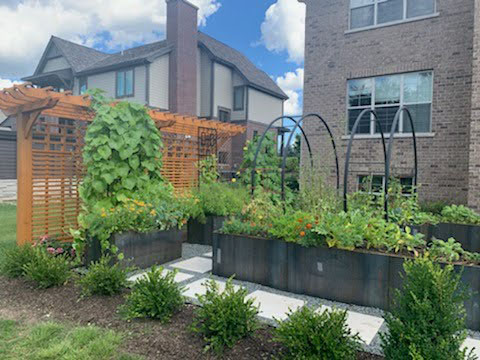Container Gardening What Is The Best Lining To Use?
Posted by Amy Ryan on 1st Feb 2023
Leading landscape Designers No Longer Line their Garden Containers with Styrofoam.
Container gardening is a great way to grow your own food in small spaces, but how you line your planter container can make a big difference. While Styrofoam seems like an attractive lining option, there are risks to using Styrofoam as a garden container lining.
For years, many Landscape Designers have used Styrofoam to line the inside of their garden planter containers and kitchen gardens because it lightened the load and was thought to improve drainage for potted plants. However, this is no longer a common practice and there are several reasons why designers have stopped using Styrofoam. It may not be what you think; keep reading to learn more.
Four reasons NOT TO USE STYROFOAM in your Garden Planters
- Does not dissolve and adds to land fill build up
- Desegrates into microplastics the seep into out water system harming fish, anamils, and humans
- Styrofoam blocks plants access to nutrients
- Stunts growth and weakens foliage which renders your gardening efforts futile.
Don't let an inexpensive short-term fix cost you a lot more than just money in the long run!
There are many eco-friendly options available that serve the same purpose as Styrofoam and are healthier for an edible garden
Container and kitchen gardens are becoming increasingly popular as people recognize the benefits of growing their own food. Fortunately, there are now many eco-friendly container options available for gardening that serve the same purpose as Styrofoam but are much healthier for your edible garden. Healthy container gardening practices include using high quality potting soil, choosing containers made from non-toxic materials such as Certified American Steel and Aluminum and setting up drainage systems to avoid root rot. Choosing eco-friendly garden container options can help you create healthy landscaping that allows you to grow nutritious vegetables and herbs without polluting the environment.
Line your garden planter containers with healthy alternatives including newspaper, cardboard, wood chips, and straw
Planting a kitchen garden in your backyard garden, front yard garden or side yard can be an enjoyable project with overall beneficial results including fresh produce and beautiful flowers. When planting these types of gardens in containers, you may consider lining your planters. Keep in mind, high-quality metal planters with drainage do not need to be lined; however, tall planters can be heavy and expensive to fill. Healthy alternative materials to Styrofoam to lighten the load and improve drainage try newspaper, cardboard, wood chips, and straw. These materials may provide aeration, help to retain moisture, reduce weed pressure, and deter pests – all while preserving the roots of your plants! Choosing the right material for your front yard garden will ensure that you have beautiful plantings to enjoy all season long!
Using eco-friendly materials in your landscape design is better for the environment and helps reduce pollution
Landscape design has come a long way from the traditional garden variety of green grass with a few leafy shrubs. Utilizing eco-friendly materials for container gardens, kitchen gardens, front yard gardens, backyard gardens and traditional edible gardens have become increasingly popular ways to make your outdoor space more sustainable. From composting and rainwater capture to using sustainable, organic, metal containers to create garden beds, utilizing eco-friendly design solutions will not just beautify your garden but will also help reduce pollution that's been caused by conventional landscape designs of the past. Not only is this better for the environment, but it can also save you money in the long run.
You can have a beautiful, eco-friendly garden without using Styrofoam or other harmful products. Drug Watch Promoting Safety & Health Information There are many alternatives available that serve the same purpose and are better for the environment. These alternatives include gravel, cardboard, wood chips, and straw. Using eco-friendly materials in your landscape design is better for the environment and helps reduce pollution.
Is healthy, safe, and environmental gardening important to you?
Check out our line of USA sourced, designed, and hand machined metal garden products that qualify for LEED points for sustainable and regenerative materials, human health, and environmental health.



